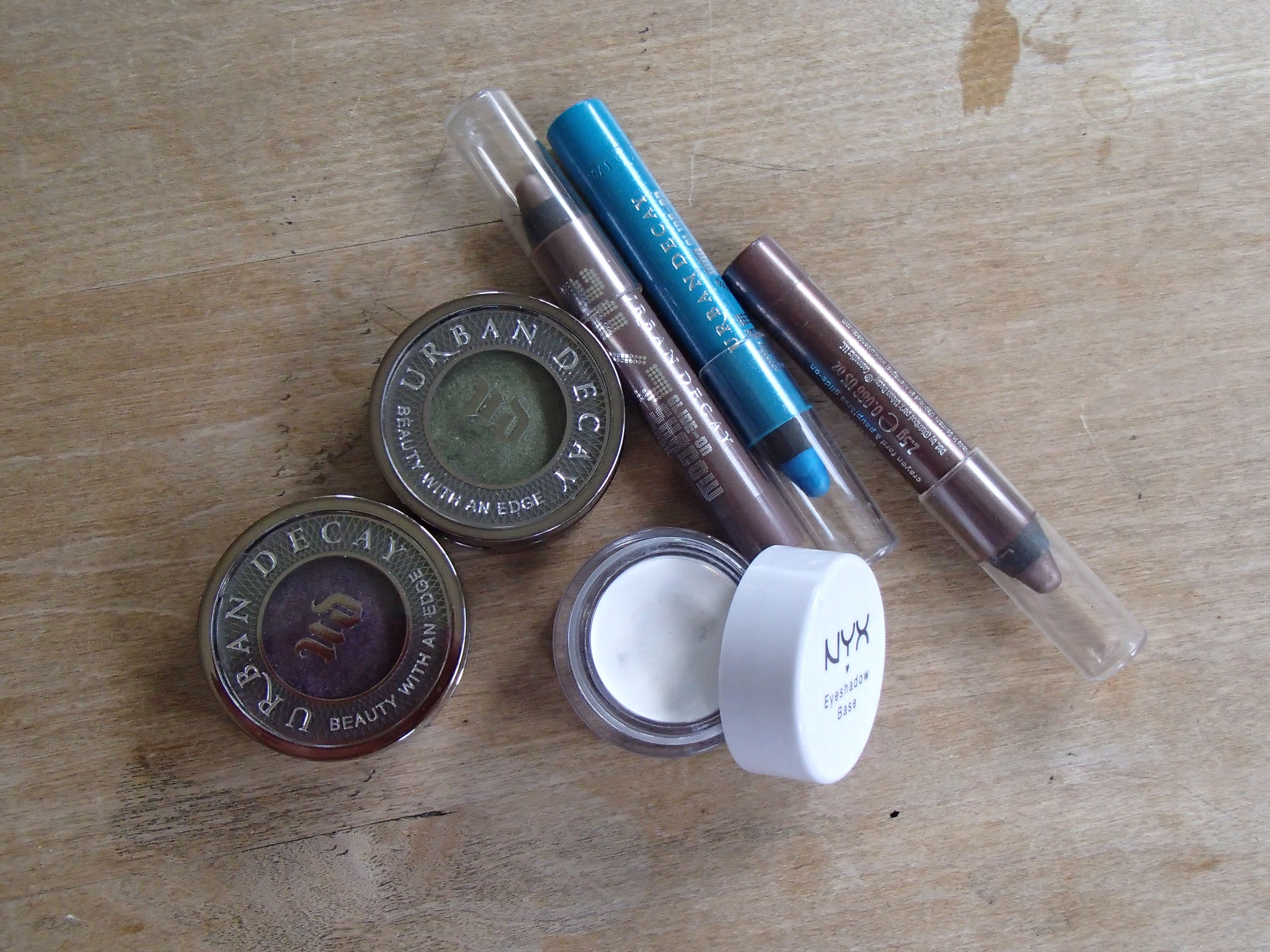
How to Makeup: Eye Primer & Eyeshadow
Part four of the How To Makeup series.
You guys! I’m so excited to get started on the eye makeup section! Eye makeup is where I feel like you really get a chance to get creative and make a lot of different looks. There’s also a huge array of techniques and products to play around with, so for me, this is where the fun really happens. So let’s talk about a couple of the first products you’ll want to use.
Eye Primer:
What is it?
A liquid or cream base for your eyeshadow. It’s usually colorless or neutral colored.
Why might I want to use this stuff?
Just like the rest of your skin, sometimes the natural oils on your eyelids can cause eye makeup to wear off more quickly. The folds in your skin can also cause your eyeshadow to move around, creating a lovely phenomenon called creasing.
Aside from increasing the wear time of your eye makeup, eye primers can also provide a neutral or colored base to make your eyeshadow colors appear more vibrant, or camouflage discolorations on the eyelid area.
How do I choose the right one for me?
Consider what your goal is. Does the pigmentation of your eyeshadow need a little help? If so, a white or black base might be the way to go. Need to cover up some veins or freckles? Look for a skin-tone eye primer. Having trouble getting your eyeshadow to stay put for more than a couple hours? A colorless primer will help control oil and keep your shadows from migrating. Primer performance is influenced by how oily or dry your eyelids are, so as always, there will be a certain amount of trial and error involved.
My favorites
Like the rest of my skin, my eyelids get incredibly oily. They’re also hooded (the skin folds over itself), so without a good primer & eyeshadow combo, my eyelids are crease city – see the photo above for proof. My hands-down favorite eye primer for oily lids is NARS Smudge Proof Eyeshadow Base. Lorac Behind the Scenes Eye Primer is a close second, though it doesn’t keep my shadow crease-free for quite as long; it is much cheaper per ounce, though.
Eyeshadow:
What is it?
A colored powder or cream that’s safe for use around the delicate eye area.
Why might I want to use this stuff?
Eyeshadow is one of the main tools for enhancing your eyes. It can be as simple as using neutral colors to contour and highlight your eye area, or you can go all out with a really colorful look. With the right placement, you can also visually change the shape of your eyes, making them appear smaller, larger, more wide-set or… well, you get the idea.
How do I choose the right one for me?
A lot of this is a matter of personal preference, since the options are pretty much limitless. Different types of shadow will have different effects, so it also depends on the overall ‘look’ that you want. When I’m choosing a shadow, the things I consider are quality, formula, finish, and of course, color.
Quality
Quality eyeshadows can be found in all price ranges, but here are some things that generally indicate a better eyeshadow-
- Pigmentation – the color should show up approximately the same on the skin as it does in the pan, and you should be able to see the color on your skin without having to use a ton of product.
- Texture – the product should be soft enough to pick up easily on a brush, but not kick up powder everywhere or fall out all over your face. It should spread over your eyelid easily.
- Wear – wear time is influenced a lot by your skin and eye shape, but some shadows are more prone to fading or creasing than others.
Formula
The three main formulas for eyeshadow are cream, pencil and powder.
- Cream – usually comes in a little pot. These can be great as a base for powder eyeshadows, and generally spread and blend easily. They stick to the skin well, so they can work really well for dry eyelids or people with eczema. Some people with oily skin find cream shadows to be more prone to creasing.
- Pencil – these come in fat pencils that are big enough to cover a large portion of your lid quickly. They tend to be long-wearing, but are a little more difficult to blend.
- Powder – this is the most common type – pretty much every makeup brand makes them. You can get them as single shadows or in palettes with multiple colors.
Finish
The finish you choose contributes a lot to the overall finished look, so choosing your finish wisely is important. The main types are-
- Matte – reflects very little light. Matte shadows are great for natural looks, and they’re also very forgiving of uneven skin texture. They’re also great for eye contouring, since darker matte colors can make certain areas of the eye appear to recede.
- Satin – also known as pearl, or sheen, or probably lots of other marketing words. These reflect a bit of light and add just a bit of shine. They can emphasize wrinkles or creases a bit more than matte shadows, but depending on the amount of sheen, they don’t necessarily emphasize them. The reflected light can visually bring an area of the eye ‘forward’.
- Glitter – or shimmer. These shadows often have visible particles of micro-glitter mixed in with the powder. They’re wonderful for dramatic eye looks, but can emphasize uneven skin texture. Glitter shadows can also be more prone to fallout (eyeshadow falling from the eye area onto the rest of your face) and some can tend to cling to brushes.
Color
Eyeshadow comes in literally every color of the rainbow. The type of look you’re creating will dictate the colors you choose.
My favorites
I’m not even going to try to pick specific colors, but some of the ones you’ll find the most of in my collection-
- Urban Decay 24/7 Shadow Pencils
- Urban Decay Eyeshadow
- Laura Mercier Eye Colour
- LORAC Eyeshadow
- Burberry Beauty Sheer Eye Shadow Eye Enhancer
Fin.
You made it to the end! Feel free to comment below if you still have any unanswered questions.


Leave a Reply